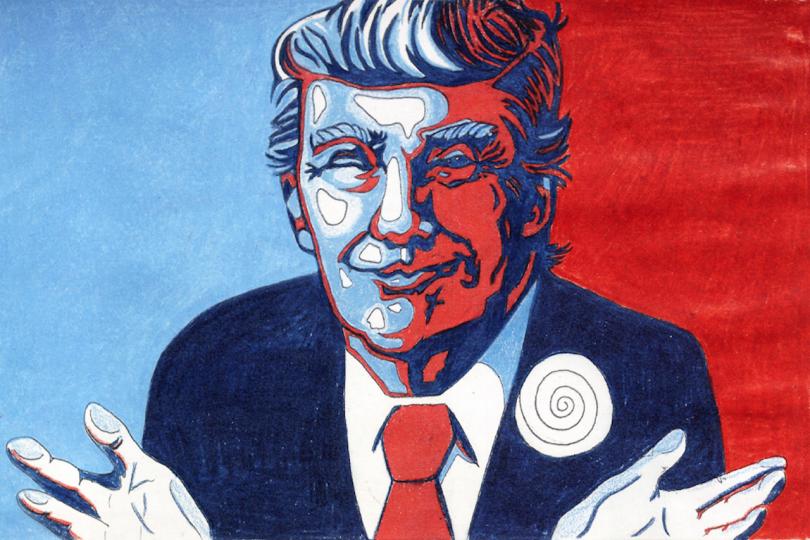Day 6: It Goes Well with Red and Blue

Editor's Note: The following review contains plot information and twists from the shows that it covers: Trump’s America (It’s Hell), A Good Ol’ Fashioned Presidential Debate (Of the Top Six 4th Party Candidates in America Today), and Ubu Trump. If you're planning on seeing these shows- you may wish to come back AFTER and enjoy this review.
In the last several years, I’ve been rearranging my life to study the cultural dimensions of democracy and how the arts are used to transmit the skills and values necessary for a people to govern themselves effectively. It, like most academic and political pursuits, has been a thrill a minute.
So when I was looking at the Fringe lineup, I naturally gravitated toward this year’s political offerings. If my half-remembered anecdotal analysis is correct, the number of shows dealing with the political sphere spikes in election years at Fringe. This certainly appears to be true for 2016: The name “Trump” appears in three show titles and, on Monday night, I saw two of them plus a third show about the election: Trump’s America (It’s Hell) presented by F.E.A.R. Productions at Mixed Blood Theatre, A Good Ol’ Fashioned Presidential Debate (Of the Top Six 4th Party Candidates in America Today) presented by Damn You Banana Productions at Phoenix Theater, and Ubu Trump, an adaptation of Ubu Roi by Trouveres Theatrics at HUGE Theater.
(Full disclosure: I’m producing a politically themed show this year myself—It is so ordered: The Supreme Court’s Greatest Hits at Intermedia Arts—and I am founder and president of American Civic Forum. The concept behind my show, however, is more an experiment in art-as-education and it deals with politics squarely outside the milieu of elections and campaigns. Draw your own conclusions about whether or not it’s an insurmountable conflict of interest.)
Precisely speaking, these three pieces are not what I would call political shows—and, in fact, Trump’s America (It’s Hell) makes no claim to be political at all. At least, they are about current events—or, rather, extrapolated from current events. At most, they are about campaigns. I will explain the difference.
Now, Americans tend to conflate grassroots politics with campaigns even though, in reality, campaigns are only sustained advertising stunts designed to make us feel like we’re engaging in serious discussions about serious issues. Despite what most people think, electoral campaigns are the absolute worst venue to have serious discussions about serious issues. (If you want to reform the primaries, for example, start writing letters to your state party’s central committee now, not the night before Super Tuesday 2020.) But electoral campaigns are all about expressing personal choice, something that Americans are generally well equipped to understand and handle.
This means that, for most Americans, citizenship isn’t so much an active, thoughtful craft as it is another facet of our inimitable, sacred role of consumer. Reflect, for example, how many people you know—there are probably many—who measure a policy’s democratic validity by how little compromise was necessary to enact it. This is in fact a democratic paradox: Leaving boring meetings slightly disappointed in their outcome is a predictable result in a democracy, not evidence of how broken the system is. And, while politicians and parties are often blamed for imposing this citizen-as-consumer model onto an electorate that would otherwise be intellectually curious and totally engrossed in day-to-day governance, the fact is that parties and officials must accept this superficial campaign-centered culture mainly because it’s the only way the most people pay attention to government.
Long story short, if you want better politicians, be a better citizen—but few people really have that kind of commitment. So… I don’t know.
Social science is super fuckin’ depressing, y’all.
At any rate, all of the shows I saw reinforced this consumerist form of citizenship and the terrible political habits it promotes. None of them really offered much in the way of political analysis or discussion or advocacy. Indeed, the fixation on elections and campaigns—a fixation that clearly inspired a lot of the political content in these shows—leads to a distinctly anti-political kind of vibe, a vibe that’s exceedingly common in nominally “political” art.
As I said, Trump’s America (It’s Hell) does not really claim to be a political show and only makes passing references to the 2016 presidential election as a way to explain why a future version of Minneapolis is a post-apocalyptic hellhole. They could have skipped politics and instead injected science fiction pseudo-physics nonsense into the script to explain their dystopia’s origins. “Trump,” “Aryan,” sadistic people with Southern accents are all in the show and are all utterly immaterial. It could have just been “wormhole,” “Omicron Persei 8” and smart, emotionally distant people with English accents.
What is most perplexing to me is why a cast that has such (relatively) long résumés in improv comedy decided on a show such as this. There were moments where I couldn’t tell if the director had definitively decided if the cast was to be serious or crack a joke. Because, man, that cast really wanted to crack jokes. They should have made it a comedy. I think everyone would have been a lot more comfortable with what was going on.
Even though A Good Ol’ Fashioned Presidential Debate is more explicitly both about “politics” and a comedy than Trump’s America, I felt that both the politics and the comedy were slightly under-baked. There were legitimately funny, even shrewdly funny, moments in Debate, but much of the comedy was roughly at the level of an old Jay Leno monologue. That was, for me, hopelessly distracting. (If it’s not clear by now, I get much more distracted by these things than normal human beings, so take this particular criticism with an appropriately James Madison-shaped grain of salt.)
The premise of Debate is that it is a forum of also-also-also-rants: Six unyieldingly abnormal candidates from six extremely marginal political parties debate. The moderators are two partisan if obscure cable news people. Without a doubt, the single best part was Blade Storm, a supervillain who wished to become president to bring superhero Solarman to heel. Rhett Romsaas as Blade and Lance Morgan and Solarman were among the best performances I saw in this trio of shows—and I would really have loved a show that used the conceit of a campaign debate as act one in a full story centered on those two characters. In the end, one of the fourth-party candidates we meet eventually does win the 2020 presidential election and calamity (here, the unceremonious destruction of millions of lives) ensues immediately after she takes the oath of office.
Ubu Trump was the most politically (and perhaps theatrically) ambitious of the three shows, which is why its shortcomings are the most maddening. I have pages and pages and pages of notes, but my focus keeps returning to one place: The Donald uses hypnosis to get otherwise hostile crowds to support him. And I want to know why, in a story that is meant to cut to the emotional bone with no sentiment or pity, that creator Shadow Zimmerman decided to simply exonerate Trump’s real-life supporters of all their ugliness this easily? Why do Trump voters have no agency—why are we to believe they are tricked into believing him? Why do we, as citizens, always forgive ourselves for the mistakes we make and for the horrible things our country does that we permit, enable and encourage? And why do so many artists who dabble in politics refuse to hold their compatriots accountable?
Zimmerman says, “Donald TRUMP is everything wrong with the American people today.” Okay, then explain why we live in a moment that makes him possible, explain why Trump is a symptom of something deeply sick within our polity. Trump is only surprising and inexplicable if you are naïve about America and a whole lot of Americans. Trump is exploiting a weakness; he is a symptom, not the cause of the sickness nor the sickness itself. We (or a sizable, vocal part of us) enable him, not vice versa—that is the very premise of a republic, even one that is flirting with cannibalizing itself as its own coup de grâce. The target of Ubu Trump’s satire is a phantom, and it’s an arm’s-length satire, one that holds up a condensed caricature of its subject culled from “Saturday Night Live” or “South Park” as the object of ridicule.
That said, Ian Garrett Sutherland did a great job with Trump’s voice. And Monica Ravitch’s grumbling, weary apologies to the audience (“Just… get ready for the Clintons. It’s after this.”) were delightful. I really want to spend a chunk of time talking to Zimmerman about theater and politics. At least it stirred my curiosity.
So, after all this, I’m left with one big question:
What the hell is with the contemporary fascination with decline, collapse and rot?
Because, as different as they were, all three shows hammered away at the idea that America is circling the toilet and that we’re on the precipice of doomsday. They were practically enamored with this idea. America’s Next Top Civil War was the theme behind my evening and, to a degree I don’t care to think about, quite a lot of political art in the present-day United States. What does it say about us that so many artists are drawn to the idea that catastrophe is unavoidable? That democracy is a ridiculous façade—performance art at best, a willful delusion projected onto an irredeemably evil system at worst? That citizens have no control over anything and, for that matter, why, if everything is a plastic lie, would we want control even if we could exercise it?
How do such artists resist totalitarianism when asked? Do they?
And maybe that’s why so much of the content in these shows fell so damn flat. It’s difficult to listen to a bit like the one in A Good Ol’ Fashioned Presidential Debate that lists a bunch of significant differences between our two major political parties and then follows it with a punchline that proclaims, Who cares? Both parties are basically the same! I can’t come to any conclusion other than Who cares? is the actual message these artists—and scores of artists who approach politics in the same way—intend to deliberately convey. It is repeated in a million little ways on an infinite loop.
The only explanation the social scientist in me can come up with? It’s strictly a back-of-the-napkin calculation, but: Nonwhite Americans tend be markedly more optimistic about this country’s future than white Americans do. And not to put too fine a point on it, but these shows are white. White politics for white audiences made by white artists about the gratifying, almost entirely white mania for imagining political chaos as a form of wishful fillment or catharsis or a test of personal greatness. Only one of the 18 people I saw on stage this evening was an artist of color—a ratio that falls far, far short of the 31% of this fall’s electorate that will be something other than non-Hispanic white. (Unless, of course, I’m misidentifying someone. That’s certainly within the realm of possibility. I mean, it’s not like I sent out a survey.) A homogeneity like this results in important absences, particularly when politics are concerned. For the most part, this country’s political pessimism and dysfunction come in just one color... and, unfortunately, it goes well with both red and blue.




